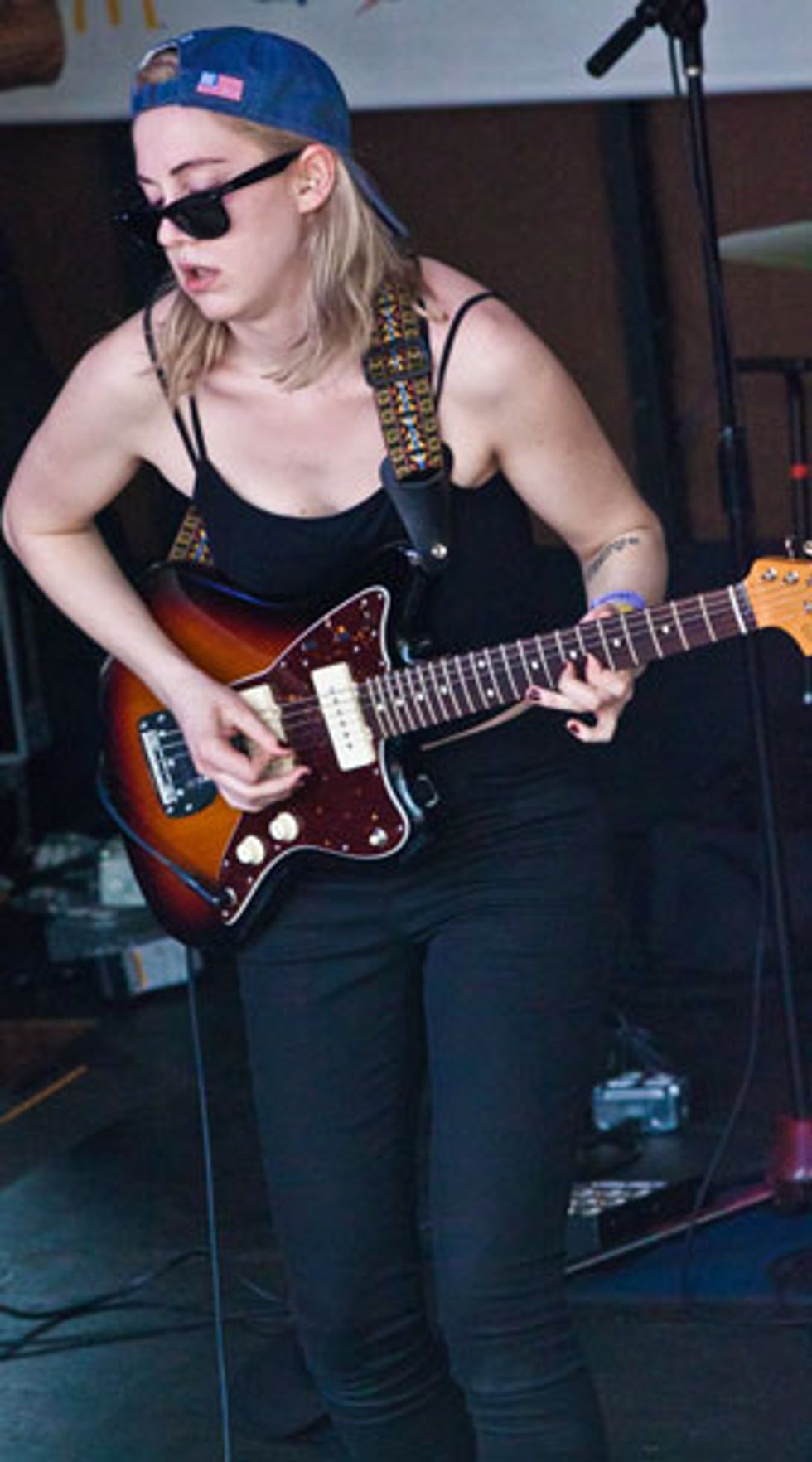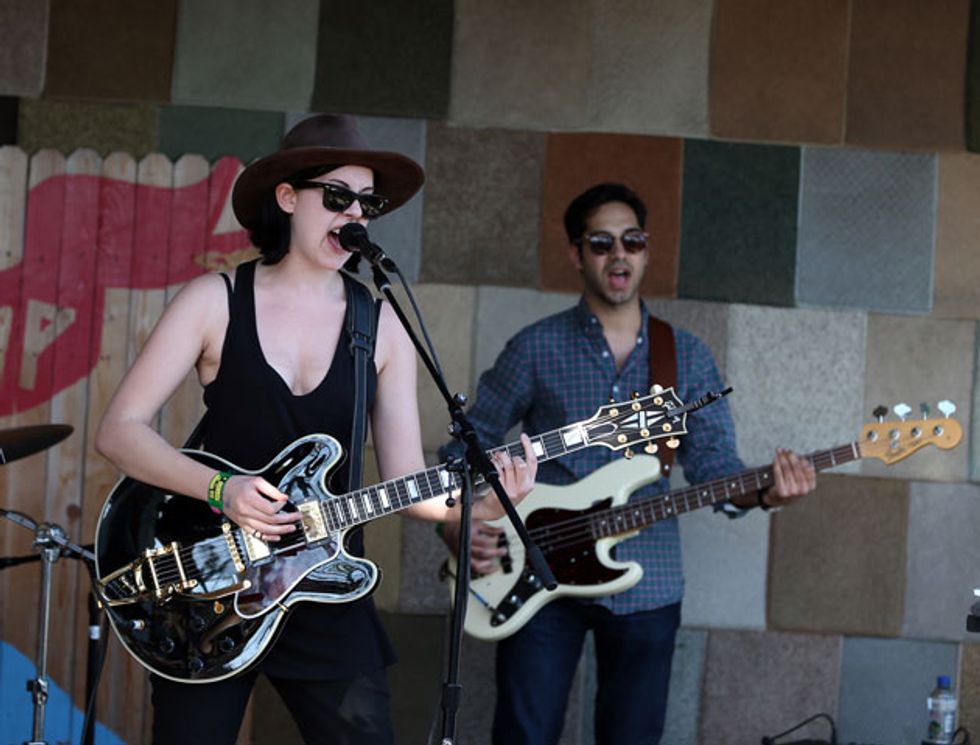Macon native and Brooklyn transplant Mackenzie Scott—aka Torres—commands much attention these days. Rolling Stone called her “a force to be reckoned with” and NPR thinks that Sprinter, her new release, “is an album we’re going to be talking about throughout the year.” But they’re just stating the obvious: Scott is a powerhouse. Her songs are emotional juggernauts that fuse intense lyrics with an onslaught of fantastically creative guitar work.
Scott’s tone palette is immense. She conjures sonic colors ranging from edgy and abrasive to delicate and subtle. Her right-hand approach is unorthodox: classical-style fingerpicking on an electric, usually a beautiful black Gibson ES-335 or an abused Fender Jazzmaster. She enhances it via her collection of mostly boutique pedals and a cranked Fender Blues Junior. Her innovative capo use pushes the creative envelope even further.
Though raised in Macon, Georgia, home to the Allman Brothers, Otis Redding, and Little Richard, Scott was unconnected to her hometown’s rich musical past. “I grew up mostly oblivious to the fact that all these greats had come from my hometown,” she says. “It’s pretty funny, actually.” She listened to ’90s pop and sang Broadway show tunes, but eventually gravitated to the disparate sound worlds of Johnny Cash and Nirvana. “I discovered everything that I really love later, when I was in college.”
With its dark moods and understated intensity, Sprinter—Scott’s second release—is a testament to her growth as a songwriter and her inventiveness as a guitarist. It was recorded at an alternative space in Dorset, England, with Robert Ellis (PJ Harvey). “It was a room that had formerly been used as a children’s nursery,” says Scott. “The owners converted it into a space conducive to bands and artists.” Some recording was also done at the studio of Adrian Utley (Portishead), and Ellis, Utley, and others play on the album. “Rob got musician friends of his to play on the record,” she says. “They were all very generous—with their time and otherwise.”
We spoke with Scott about her influences, unorthodox playing style, and gear, and how she creates such wide-ranging tones. Despite the dark themes and rock ’n’ roll swagger of her music, Scott proved easygoing, humble, and fun to talk to.
When did you start playing guitar?
I was about 15 or 16. I was in a youth group with this girl who played guitar. I thought it was so cool. I’d had a guitar for years, but I’d never really touched it. I finally picked it up and started teaching myself.

Torres working her new-ish, stock Fender Jazzmaster during a solo in her song "Sprinter" at the Mohawk Outdoor stage during SXSW in Austin, Texas.
Photo by Chris Kies.
Did you want to become a guitarist, or did you see it more as a vehicle for singing and songwriting?
It was more about the singing and songwriting at first. I suppose it still is—that’s always the priority for me. At the time it was definitely a vehicle for the poetry I was writing. I was just starting to sing and let some family members and friends hear me, which was hard for me to do. At first, guitar gave me something to hold while I was singing—something to hide behind. But now the guitar has been completely transformed for me.
How so?
I don’t really play acoustic anymore. I play it at home, but I really just like the electric. I’m just learning, figuring out what I like to play and trying to get better at it. I especially love fingerpicking on the electric guitar. I’ve loved doing that since I picked up the electric guitar.
I noticed that you don’t use a pick.
I don’t.
Are you looking for a specific timbre, or is that more just how you play?
That’s just how I play. When I initially started teaching myself, it was only fingerpicking. For some reason my inclination was to play “classically” rather than strum power chords. Eventually I had some classical lessons, which reinforced that preexisting inclination. When I started playing electric guitar I realized I could plug in and use some really sweet pedals for some sonic variation while playing in that style. That’s something that I continued to do. I still don’t use a pick.
Do you use your nails or the flesh of your fingers?
I use both. Actually, the index finger on my right hand is permanently disfigured on the front. It’s always skinned, and my nail is always halfway off.
Do you hold your index finger and use it like a pick?
Yeah, I do. I switch back and forth between fingerpicking and strumming with my nail.
Mackenzie Scott got her “dream guitar," a Gibson ES-335, as a Christmas gift from her entire family a few years ago. “I’d had my eye on it for a couple of years, but I never thought I’d ever have a guitar like that,” she says.
Photo by Jonny Victorsson.
When did you get your 335?
It was a collective Christmas gift from my entire family a few years ago. I’d had my eye on it for a couple of years, but I never thought I’d ever have a guitar like that. It’s my dream guitar. I don’t bring it out on the road as much as I’d like to because I’m terrified of something happening to it.
Did you mod anything on it?
No, I didn’t do anything to it. I’m thinking of taking off the Bigsby, though, because it makes it go out of tune so easily. But it’s a beautiful guitar, and I love the semi-hollow design. I love the way the neck feels. It’s a heavy guitar—it’s big and burdensome. But my 335 makes me feel like I have something massive in my arms growling. It’s a beast.
It must feed back easily.
Oh, yes. If I plug it into any of the pedals I have and turn my amp up, I can just hold it in the air, and it feeds back.
You really use that feedback on the album.
I did, yeah. I let that happen naturally.
You have a Jazzmaster too.
I do. I love the Jazzmaster. It’s a lot lighter than the 335. I love the neck on it. I like the range. And it gives me more room to get a little violent with it. My 335 has to be handled with care, but I just rip on the Jazzmaster. There have been times when I played it, finished a song, and then took it off and threw it on the ground.
Really?
And it totally holds up. It’s great.
You’re the second person I’ve spoken to recently who trashes Jazzmasters.
I don’t know why. The Jazzmaster is just asking to be thrown around.
You don’t play many open chords, yet you often use a capo. Why?
The capo allows me to get strange sounds when I’m fingerpicking. I experiment with the capo, fiddling around till I find some sort of hook that I can play repetitively. The capo gives me more options.
Are you looking for different harmonics, or different ways to use open strings?
I play with open strings sometimes when I’m doing that. It allows me to move more freely on the guitar without having to barre with my finger. It gives me a variation in notes and makes it easier for me.
You’ve said your goal is to become a better
and better player. What do you do to grow as a guitarist?
What I do is listen to records I’ve never heard before—that I never would have listened to—and expose myself to styles I didn’t even know about. As I am evolving, becoming an adult, my musical tastes are expanding. I’m listening to a lot of Robert Fripp and Funkadelic—stuff I never had any real appreciation for until the last couple of years. Captain Beefheart, too.
Gear
Guitars
Recent-model Gibson ES-335 (stock)
Recent-model Fender Jazzmaster (stock)
Vintage Silvertone 1435
Amps
Fender Blues Junior
Effects
Fulltone Fulldrive2 MOSFET
Fulltone OCD
Earthquaker Devices Organizer
Line 6 DL4
Death By Audio Echo Dream 2
Which album?
Trout Mask Replica—I guess it’s the most famous one. You’d think maybe I would have heard that earlier in life. But that’s the theme: Not hearing about the classics until I’m in my twenties.
How about Funkadelic?
Maggot Brain, the self-titled one, Free Your Mind ... and Your Ass Will Follow—all that stuff. I love it. I’m still obsessed with Nirvana, but I know what that sounds like. I’m trying to listen to stuff I haven’t before, letting it seep in. Once something slips into my subconscious, it’s only a matter of time before I start experimenting in that vein on the guitar.
Talk about your songwriting process. Do you craft music to fit your lyrics, or do you come up with riffs and write lyrics later?
It’s a little of both, but primarily the former: I have a lyrical idea that I then base a melodic hook around. But sometimes they come at the same time.
Does the meaning of your lyrics warp into something different once you put music to them?
The lyrics definitely take on multiple meanings. But the lyrics heavily dictate the melodies, which is the most effective way that I’ve been able to write songs thus far. I have a hard time writing melodies that aren’t dictated by a lyric.
Mackenzie Scott alongside co-guitarist Cameron Kapoor owning the Mohawk Outdoor stage in Austin, Texas, on 3/18/15 during SXSW at Paste's official showcase. Photo by Chris Kies.
Do you use effects as songwriting tools, or do you search for specific sounds only after the songs are written?
It’s more the latter, especially for this record. I wasn’t writing with the pedals, but as soon as the lyrics were written, I was working on the sounds. I had the melodies—I was just trying to get the sounds for the recording. A lot of times I had the sonic palette in my head, and I was fiddling with the pedals to get the exact sounds that I heard.
Robert Ellis coproduced your new album. Was part of his role helping you to figure out some of those sounds?
The guitar sounds were mostly established before I went to England to record with Rob, but he definitely helped me to solidify the sounds of the other instruments on the record.
Did he play on the record, too?
He played drums, synthesizers, and some random toys. His primary role was producing with me and playing some killer drums.
What’s the cool effect at the end of “New Skin?”
There are a few layers there. I played my regular part, and then we detuned a couple of guitars—one sharp and one flat—and played them over the top to make everything sound warbled and out of tune.
You can hear a lot of finger noise on “A Proper Polish Welcome,” but it seems obvious that you did that on purpose.
I wanted to create some subtle atmosphere. On that song I’m sliding my hand across the strings because it’s the smoothest transition I can make, but I didn’t see the string noise as something to be eliminated.
What guitar do you use in the video for the solo version of “Cowboy Guilt?”
That’s a vintage Silvertone—I believe it’s from the ’50s or ’60s. A friend put it up for sale, and I immediately replied, “I want it.”
Do you take that on the road?
I haven’t yet. I have some setting up to do—it has a few broken knobs and things that need to be fixed. It hasn’t been tampered with since it was originally made. After I make some updates, I think I will be taking it on the road.
YouTube It
Scott leads her band (including co-guitarist Cameron Kapoor) through a dynamic rendition of title track from Sprinter.
The solo version of “Cowboy Guilt” is very different from what you put on the album. How do you get those tones on the album?
That’s mainly the Earthquaker Devices Organizer pedal. For the live solo version I chose to play it as it was originally written, before I added the effect.
You can see how you use the capo in that solo video. The open strings create a nice little dissonance.
Yeah. That was one of the things I was talking about when I said that using the capo gives me a bit more freedom when I’m trying to figure out a melody on the guitar. I got a sound using the capo on the second fret that I wouldn’t have gotten if I’d played that song in standard tuning without a capo.
Live, you augment your lineup with a second guitarist. Do you have a specific role in mind?
Yes, I do. I often switch from playing rhythm to lead guitar in the middle of the song, and I have the second guitarist pick up the rhythm part.
Are you specific about what you want, or do you give the other guitarist room to be creative?
A lot of times I have a specific part that I want each band member to play, and sometimes there is a little more freedom. Cameron Kapoor, the guitar player on the road with me now, is an extremely innovative player, and he really works well within the sonic world I created on this album. I was able to give him a lot more freedom than I’ve given players in the past because I trust his instincts. I tell him if I don’t like something, or give direction if I want him to switch gears.








![Rig Rundown: AFI [2025]](https://www.premierguitar.com/media-library/youtube.jpg?id=62064741&width=1245&height=700&quality=70&coordinates=0%2C0%2C0%2C0)












 Shop Scott's Rig
Shop Scott's Rig













 Zach loves his Sovtek Mig 60 head, which he plays through a cab he built himself at a pipe-organ shop in Denver. Every glue joint is lined with thin leather for maximum air tightness, and it’s stocked with Celestion G12M Greenback speakers.
Zach loves his Sovtek Mig 60 head, which he plays through a cab he built himself at a pipe-organ shop in Denver. Every glue joint is lined with thin leather for maximum air tightness, and it’s stocked with Celestion G12M Greenback speakers.












![Devon Eisenbarger [Katy Perry] Rig Rundown](https://www.premierguitar.com/media-library/youtube.jpg?id=61774583&width=1245&height=700&quality=70&coordinates=0%2C0%2C0%2C0)






